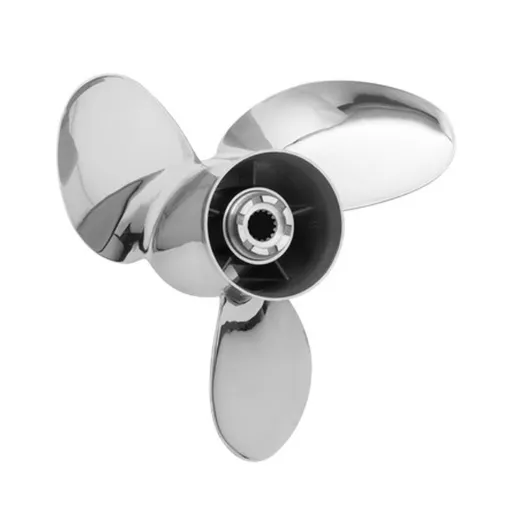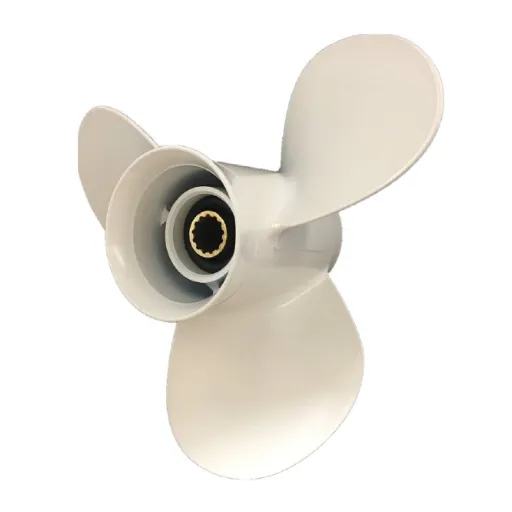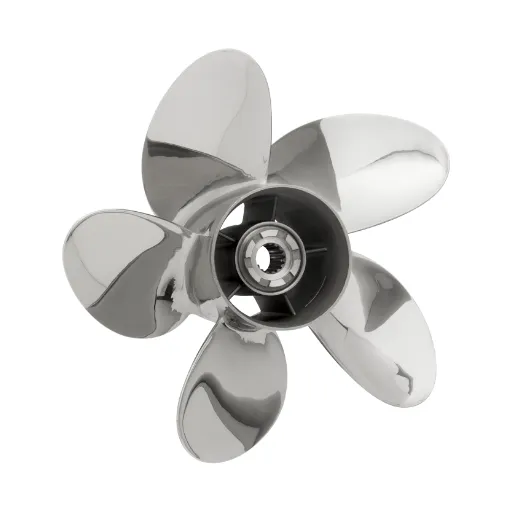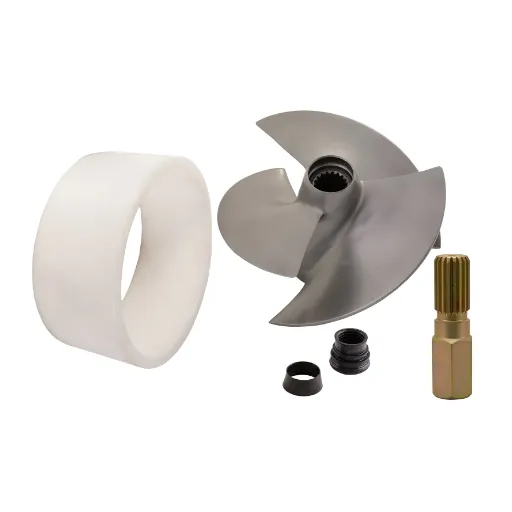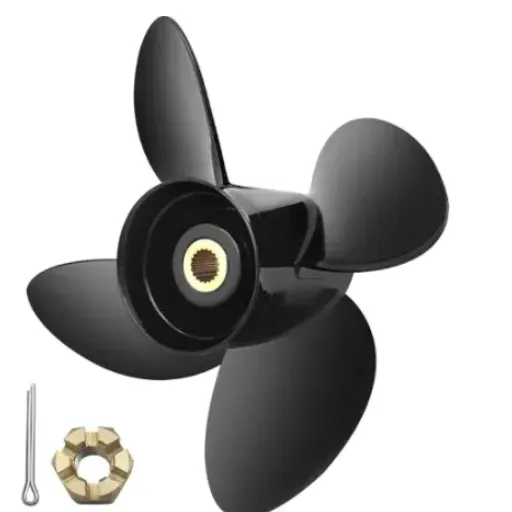Selecting the correct propeller for your boat can be an intimidating task due to the plethora of choices offered. Among all the options, the two most common selections are aluminum and stainless steel propellers, each providing specific benefits depending on your boating requirements. Whether you want increased speed, better fuel consumption, longer life, or simply better performance, knowing the primary differences between these materials is very important. We will discuss all aspects of aluminum and stainless steel propellers in such a way that you will end up making the right decision that not only fits your boat but also makes your time spent on water great. First, let’s analyze the advantages and disadvantages before determining the best one for your boating experiences!
Material Differences: Aluminum and Stainless Steel
Composition and Properties of Aluminum Props
Aluminum propellers are one of the main selections for boaters because they are economically priced, readily available, and effective. Light-weight mainly aluminum alloys are their composition which makes manufacturing them and making them cost-efficient even compared to stainless steel. The reduction in total weight through the use of aluminum results in more efficient engine performance because the load on the engine is lowered. The ability of the modern aluminum alloys has been advanced through technology and they are now of greater strength and durability, thus making them usable in a broad spectrum of boating applications, like-drilled wells, recreational and light-duty commercial use.
In terms of performance, aluminum props are best fitted for lower horsepower engines and boats operating at moderate speeds. The fact that they can take impact and not suffer much damage relieves them from being hard when they have to deal with debris or shallow waters. But then, aluminum is a soft material, so these propellers will be bent and worn out more easily when they are subjected to a lot of stress like high-speed boating or being in collision with hard surfaces like rocks. Still, their being repairable makes them good for the casual boaters or hobbyists.
One thing to keep in mind when it comes to aluminum props is that they can rust, especially if they are used in saltwater. Gradual direct contact with saltwater might be the cause of oxidation and pitting and these two affect the performance and life of the propeller. The use of coating like paint or anodized finishes of the highest quality to make a shield against the elements is a common way to deal with this problem; thus, the propellers remain powerful and last long. Even with these potential disadvantages, aluminum props continue to be an affordable, flexible choice that still can cater to the needs of the daily boaters throughout various conditions.
Composition and Properties of Stainless Steel Props
Stainless steel propellers consist of a durable alloy of steel and chromium, often nickel and other elements added durability and corrosion resistance, and in this way, they are up to par with the best materials one can get for marine props. The chromium oxide coating protects the underlying metal from getting rusty and deteriorating even in the harshest of marine environments. Thus, stainless steel props become a highly durable and reliable choice for the performance-minded boaters who do not mind working with equipment that can withstand the rigors of marine conditions for a long time.
One of the main advantages of stainless steel props over the rest is their rigidity. Such rigidness allows the producer to create more accurate blade shapes which, in turn, leads to an improvement in hydrodynamic efficiency and a performance boost as compared to the aluminum alternatives. Competition among the blades will lead to an engine which will consume less fuel. Besides, the longevity of steel propellers makes it easier for them to endure impacts when they happen and thus they won’t be bending under load.
Stainless steel propellers, traditionally, are a more costly initial investment compared to aluminum ones, but their toughness, longevity, and performance gains can justify the spending even to occasional boaters or to those using them in tougher conditions. With the help of contemporary production techniques as well as metallurgy breakthroughs, stainless steel propellers still hold the position of the most reliable and efficient in the industry when it comes to boating applications.
Key Differences Between Aluminum and Stainless Steel
Aluminum props are a cost-effective choice, they are light and flexible, but at the same time, they are not very sturdy; on the other hand, stainless steel props are expensive, heavy, and rigid but highly durable and efficient with superior performance.
| Aspect | Aluminum | Stainless Steel |
|---|---|---|
| Price | Economical | Expensive |
| Mass | Lightweight | Heavier |
| Strength | Lower | Higher |
| Flexibility | Higher | Lower |
| Efficiency | Moderate | Superior |
| Repair Fees | Cheaper | Costlier |
| Fuel Use | Moderate | Efficient |
| Blade Size | Thicker | Thinner |
| Speed | Moderate | Faster |
| Shock Resistance | Lower | Higher |
| Purpose | General | Performance |
| Setting | Freshwater | Saltwater |
Performance in Various Boating Conditions

Speed and Efficiency: Aluminum vs Stainless Steel
Aluminum propellers yield a speed and efficiency that can be described as moderate, while at the same time, the use of stainless steel propellers results in higher speed, better fuel consumption, and top performance.
| Aspect | Aluminum | Stainless Steel |
|---|---|---|
| Top Speed | Moderate | Higher |
| Fuel Use | Moderate | Efficient |
| Drag | Higher | Lower |
| Blade Flex | More | Less |
| Performance | Adequate | Superior |
| Acceleration | Moderate | Faster |
Handling and Maneuverability
Generally, in terms of control and maneuverability, stainless steel propellers surpass the aluminum ones due to their higher stiffness and accurate designs. The thickness of the blades made possible by the strength of stainless steel contributes to the reduction of drag and the provision of performance control in different water scenarios. Such control gives rise to the smoothest turns and best handling, especially during high-speed situations or in difficult to manage areas like the ones with rough water or strong currents.
Aluminum propellers, for instance, while still of lower price, can easily bend under a large load or high speed, which is the case of most casual boaters. The Wobbling may cut down efficiency and handling accuracy, especially when swift and sharp movements are required. The situation of less visibility may be the case of tourists who spot calm beaches, but for those rooting for an excellent performance, stainless steel is often the go-to.
With modern propeller design constantly evolving, manufacturers are still working on refining blade shapes and configurations for both materials, thereby improving maneuverability and catering to specific boating needs. End-users, bolstered by these advancements, can now chart a path more easily through the murky waters of performance and technology and make better decisions based on their specific requirements.
Performance in Rough Waters
The challenges that come with rough water boat navigating are not only unqiue but also increase the demand on equipment and the design of the boat heavily. In such cases, which are characterized by unstable wave patterns, the propellers’ performance is very crucial since it affects stability, quickness of the boat, and control during the unpredictable rise and fall of waves. The propellers made of stainless steel, which are recognized for their great durability and strength, become the prime candidate for the rough water conditions that power the boats underneath the water and that’s the reason behind their being chosen first in such situations. The propeller manufacturers have come up with the new blade shapes and also the new engineering methods in making propeller configurations so that they can create thrust in the tumultuous water situation which indeed will serve as reliable motors for the boats.
One of the critical factors for rough waters is the trade-off that exists between blade pitch and diameter. When the balance is finely tuned it means that the boats will be able to keep up with the engine at its full speed and responsiveness without overloading it. The designs of adjustable and custom-propeller have won more popularity than before when it comes to sorting out these situations because they give the users the power to customize their propellers according to the conditions and needs. On top of that, the development of hydrodynamic technology has allowed the creation of the blades with a much better water-gripping performance that leads to the reduction of cavitation and the increase of thrust stability. These technological improvements that have happened in the marine industry are allowing very little sliding and are also giving the possibility of a very powerful grip in the rough or uncertain wave patterns – thus making the waterway safer and also giving more confidence during navigation.
Case studies on propeller efficiency in adverse conditions conducted recently have provided the data that indicates the importance of the propeller selection even more significantly. The boats with high-performance, stainless steel propellers highlighted in the studies were flying on the waves with lower fuel consumption even at occasions when the waves were considerable. This kind of conclusion accentuates the usefulness of contemporary propeller designs in providing peak performance and efficiency. With the integration of technology-driven improvements and suitable maintenance practices, the boaters can expect high reliability and functionality that can be measured in terms of safety and the overall experience rough waters offer.
Practical Use Cases for Aluminum and Stainless Steel Props

Best Applications for Aluminum Boat Props
Aluminum boat props are highly regarded by boaters mostly because they are affordable, easy to handle, and simple to maintain. The following are the five respective areas where aluminum boat props can be used best:
- Recreational Boating: Aluminum props are very suitable for the casual and recreational boaters who are looking for a cost-effective solution. Their price is much lower compared to that of stainless steel; thus they are the best choice for family fun or light-duty usage on lakes and rivers.
- Smaller Boats with Lower Horsepower Engines: Aluminum props allow boats with less than 150 horsepower engines to perform sufficiently. They are useful in conditions where speed and high torque are not primarily demanded.
- Freshwater Environments: The aluminum props in the water freshwater are, therefore, considered to be non-corrosive and this is why they are among the best in waters like lakes rivers, and reservoirs, They are also good in the right places where the saltwater is very minimal.
- Boats Used in Shallow Waters: Aluminum props have become the primer choice among shallow-water-operated boats, this being because of their lower price, where they could hit debris or the bottom more than once, hence it is more economical regarding repair or replacement.
- Backup or Spare Propellers: Due to their portability and lightweight nature, they are deemed backup or spare for many boaters as aluminum props. They are a cheap alternative to the primary propeller, which if damaged might be the cause of the accident.
Boaters will be able to choose aluminum props that suit them best in terms of needs, balancing performance and cost considerations, if they are aware of these applications.
When to Choose Stainless Steel Props
When durability and performance are my major considerations, I go for stainless steel props. The strength of stainless steel is much more than that of aluminum which makes it hard to bend or change its form even under great stress. I often sail through tough waters or places full of rocks and debris, I feel that the sturdy frame of stainless steel props gives me assurance because of its strength.
Moreover, I choose stainless steel props mainly because of their high performance. The cutting-edge technology in stainless steel props allows for thinner and more exact blades which in turn gives better hydrodynamics and results in increased speed and efficiency. Hence, these blades are very suitable for boats that need to have the best acceleration and handling, particularly if the water-related activities are high-speed ones, such as watersports or racing.
Stainless steel props cost a lot at the beginning but I think the long-term value is much greater than the cost. Their resistance to wear and tear and corrosion prolongs their life thus reducing the frequency of replacements and repairs. To me, the choice of stainless steel is mainly governed by my demand for upbeat and reliable propulsion especially when the boating conditions are extreme.
Case Studies: Performance in Real-Life Scenarios
Stainless steel propellers have always been the first choice when it comes to performance in real-life applications. To illustrate, in high-speed boating competitions, the racers often talk about the advantages of using stainless steel props in terms of the speed of the boat—the props are able to give quicker acceleration and also steady the boat’s speed when the pressure is on. One of the case studies showed a competitive boater who switched from aluminum to a stainless-steel propeller. The noticeable increment in the top speed of about 10% and also the decrease in fuel consumption because of the better efficiency were the good results of the switch.
On the other hand, a recreational fisherman in rocky coastal waters is another case. The stainless-steel propeller’s strength was put to the test and it passed with flying colors as it received the above-mentioned impacts and abrasions without losing its integrity—this was a situation where an aluminum propeller would probably have had the quick wear-out or deformation. Furthermore, there is research evidence that saltwater corrosion could not affect the precision engineering of stainless steel propellers which in turn made their performance in tough marine conditions quite the opposite of their situation in establishing-age-old ones.
Such examples from the real world simply show how much of a cleaner, more reliable, and longer-lasting performance one can expect from stainless-steel propellers given the different situations, whether at the professional racing or the recreational level.
Pros and Cons of Aluminum and Stainless Steel Props

Advantages of Aluminum Props
- Cost-Effectiveness: Aluminum pro including costless propellers are madesuch or even more affordable than the stainless-steel propellers. The choice of propeller is an excellent one for owners of boats who are very conscious ofw their budget. For such users as entry level or casual people, the lower initial investment might be an attractive factor.
- Lightweight Design: The lightweight characteristic of aluminum props not only hinders the installation or replacement but also health of sailor in case of emergencies. This characteristic also minimizes the engine’s burden in certain situations thereby contributing to small to medium-sized boats getting smoother operation.
- Widespread Availability: One of the main reasons why aluminum propellers are so popular is the variety of sizes and shapes they come in. The widespread availability of aluminum propellers makes it easy for almost all boat models to find the right ones for replacement or upgrade, and therefore the process is very smooth and cheap.
- Repairability: The soft material of aluminum allows for dent or damage of propeller to be often repaired rather than needing the complete replacement of the propeller. This can result in longer and cheaper maintenance costs for the casual boating enthusiasts.
- Fuel Efficiency in Lower Speeds: Aluminum propellers generally have a good performance at lower speeds and RPMs and thus they provide sufficient fuel efficiency for recreational boating activities like fishing or cruising in quiet waters.
Advantages of Stainless Steel Props
- Superior Strength and Durability: Stainless steel props have a much higher strength compared to aluminum, therefore they are much less prone to bending, cracking, or suffering from other types of damage. This quality still holds even in a very tough environment like over rocks and debri-filled waters.
- Enhanced Performance: With their rigid structure, the stainless steel props do not change shape under heavy loads and high speeds, thus improving the boat’s acceleration and total performance very significantly. Therefore, they are great for high-performance or competitive boating.
- Greater Fuel Efficiency at High Speeds: Stainless steel props are usually the ones giving the best fuel economy at higher speeds and RPMs. Their smooth and accurate designs contribute to the little drag created and, thus, to the water flow being less troubled.
- Corrosion Resistance: High-end stainless steel is the material that stands the test of time, that is why it is often used for marine applications and, more precisely, saltwater ones. This property gives stainless steel props their constantly in-demand status among saltwater boaters who are after reliable equipment for the long haul.
- Design Versatility for Specific Needs: Stainless steel props can be made not only with more complicated designs and thinner blades but also with custom solutions that fit a boat’s specific performance needs perfectly. This versatility makes them fit for different boating styles, from fast racing to heavy towing applications.
Disadvantages of Each Material
Aluminum Propellers
- Limited Durability: Bending and breaking are the main problems that aluminum props suffer from due to stress, especially in rocky or debris-filled waters. One may have to incur the cost of repairs or replacements if this continues for a long time.
- Lower Performance at High Speeds: Lightweight nature is the main reason for aluminum propellers to struggle in delivering optimal performance at high speeds. In fact, they are much less efficient than stainless steel ones in high-speed applications.
- Susceptibility to Corrosion: Aluminum props are commonly coated to resist corrosion, yet they are more exposed to the elements, particularly saltwater that eventually leads to their gradual degradation.
- Thicker Blades: Thick blades are usually used for the construction of aluminum propellers because of their being less strong than steel but this results in reduced overall efficiency and increased drag when compared to thinner-bladed designs in stainless steel.
- Shorter Lifespan: Having a shorter lifespan is one of the consequences of using less strong material combined with more propensity to suffer damage that is the case with aluminum props as compared to stainless steel ones.
Stainless Steel Propellers
- Higher Cost: In comparison with aluminum ones, stainless steel props are quite significantly more expensive which is a disadvantage for boat owners with a limited budget.
- Heavier Weight: Fuel efficiency would be slightly reduced and stainless steel propellers might not be suitable for boats where weight reduction is of utmost importance, due to the heavier weight of these props.
- Potential for Gear Damage: The strong character of stainless steel could lead to a situation where if the propeller strikes a solid object, the impact force may be transmitted to the drive system, ruining the gears or shaft in the process.
- Corrosion in Poorly Maintained Conditions: The top-grade resistance of stainless steel however does not mean it can withstand corrosion if not properly cared for especially in very acidic or polluted waters.
- Repair Costs: When a stainless steel prop has been damaged, the repair process is usually more difficult and costly compared to that of an aluminum propeller.
Innovations in Propeller Technology for 2025

Electric Propulsion Compatibility
The proliferation of electric propulsion systems in the boating sector has made the design of propellers an area where engineers have to come up with new concepts to match the electric motors’ performance. Electric motors’ instant torque and noiselessness make the use of such propellers which can not only but also handle well these characteristics. So, besides the introduction of new materials that are lighter, the power delivery of electric engines is further supported by the new rotor geometries. The power of stainless steel in maintaining operational precision has made it still the most preferred material, but composite materials are gaining popularity because of their weight advantages.
One of the major breakthroughs that help in this whole process is the tuning of propeller pitch and diameter according to the different torque curve of the electric motors. Electric motors, unlike conventional internal combustion engines, give out their maximum torque at very low revolutions, and this is a major factor that determines the relationship between the propeller and the water. Smaller propellers with high thrust efficiencies are being created that coincide with these traits, hence leading to longer cruising ranges and better energy usage. Moreover, the use of advanced computational fluid dynamics (CFD) modeling has become a necessity in developing the designs that cut down the drag and turbulence, and thus electric propulsion systems functioning at their very best.
The propeller of the future will not only be compatible with electric propulsion but also be able to integrate smart technologies. The sensors that are part of this system can keep track of the performance instantly and send the operators vital information about the efficiency, vibrations, and energy consumption. This information would not only aid in the current operations’ optimization but also indirectly help in the design process of the electric-compatible products. The combination of the industry’s inclination towards sustainable and environmentally friendly options along with the above-mentioned advances makes it a no-brainer to view this as a transition towards cleaner and more efficient maritime engine systems.
Anti-Fouling Coatings and Their Benefits
Anti-fouling coatings are vital for the performance and durability of ships in the ocean. These unique coatings function to stop the growth of marine organisms on the ship’s underwater parts, such as algae, barnacles, and clams. Therefore, the ships gain better efficiency, less fuel use, and lower maintenance costs because of the reduction of biofouling. Here are five major advantages of anti-fouling coatings with comprehensive explanation of their benefits:
- Better Fuel Efficiency: On the one hand, if the coatings allow the hull to be cleaned, the hull will drag less water because of the absence of marine life. This will enhance the hull’s performance and lead to a reduction in fuel consumption. Research indicates that depending on the type of fouling and its extent, up to 10-20% of fuel consumption might be saved.
- Cheaper Maintenance: Anti-fouling coated ships require fewer cleaning and repair operations because the visibly dirty and organism-infected hulls are eliminated. This ultimately leads to the reduction of dry-docking periods and hence costs of maintenance.
- Increase in Vessel Speed and Performance: A better hull surface has a more efficient hydrodynamics, hence vessels are able to go faster without the need of additional power being supplied.
- Lower Impact on Environment: Through the increase of fuel efficiency, anti-fouling coatings are indirectly responsible for the decrease of greenhouse gases emitted, which is in line with the worldwide campaign for the establishment of a more eco-friendly and sustainable maritime industry.
- The operational life of a ship is lengthened: Corrosive damage caused by biofouling could be prevented by a vessel’s hull protection, thus, its operational life would be prolonged, and durability would be guaranteed for longer periods before the need for frequently replacing or repairing comes up.
High-performance anti-fouling coatings are a way for the marine industry to reap great benefits not just in terms of operations and profitability, but also in terms of being environmentally friendly, hence being part of the larger migration to sustainable maritime practices.
Foldable Prop Designs: Space and Convenience
Foldable propeller designs have changed the marine industry by presenting new options for saving space and better functionality. These small designs are especially beneficial for boats where the onboard space is a critical factor to be considered. Foldable props are not expanded when they are not in use, which causes a cut in the drag and an improvement of the overall vessel efficiency during the sailing or the storing.
Material science progress, such as the application of high-strength alloys and corrosion-resistant composites, has even more cemented the reliability and durability of the foldable props. New designs are also powered by the latest engineering to secure smooth opening and closing, making it easy for the machine to do its job and lessening wear and tear over the machine’s life span.
Moreover, foldable props are part of the sustainable maritime practices as the drag when folded leads to the less power consumption and emissions of the vessel. Whether it is sailing yachts or designated ships, these creative propeller systems are bringing together comfort, efficiency, and environmental friendliness, which is why they are a perfect choice for the modern maritime operations.
References
-
Academia.edu – A Detailed Comparison of Various Steel Types
This paper compares stainless steel and aluminum in terms of properties, usage, and applications. -
OhioLINK – Design of Stainless-Steel and Aluminum Slide Gates
This research explores the material properties and design considerations for stainless steel and aluminum. -
University of Akron – Benefits of Aluminum in Industry
This study highlights the mechanical properties and advantages of aluminum compared to other materials.
Frequently Asked Questions (FAQ)
Q: What are the main differences between aluminum and stainless steel props?
A: The major differences between aluminum and stainless steel props are mainly based on their material properties and performance. Aluminum props are more commonly the cheaper and lighter option compared to stainless steel ones, which makes them perfect for small boats and casual use. On the other hand, stainless steel props provide the boat stronger, faster and more effective at higher RPMs, thus, they are best suited for large ships or high-performance applications.
Q: Which type of boat benefits more from a stainless steel prop?
A: A stainless steel prop is an absolute must for large boats or ones that need to perform at their best. The strength of the stainless steel props gives them longevity and they are able to stand up to the rigors of fast sailing, which in turn increases the boat’s speed and performance. Moreover, stainless steel props are an advantage for boats working in tough conditions.
Q: Are aluminum propellers considered to be a good choice for all boat types?
A: Though aluminum propellers are a widely used option owing to their economical price and light weight, they are not a recommendation for all types of boats. For demanding or larger vessels, stainless steels are often suggested due to their strong and efficient performance. Nonetheless, if the boat is small or for leisurely use, aluminum would be sufficient for the desired performance and easier than a stainless steel prop to replace as a spare.
Q: How does the performance of stainless steel compare to aluminum props?
A: The performance level of stainless steel props is usually higher than that of aluminum props. The stainless steel propeller allows for better acceleration, and handling and is also less likely to deform under load, which results in more efficient propulsion. The difference in performance is more notable in high RPM applications, where a stainless steel prop can effectively boost the overall speed of the boat.
Q: What should boat owners consider when choosing between aluminum and stainless steel props?
A: Boat owners should look into the factors like boat type, use, and price when they want to make a decision on aluminum versus stainless steel props. For instance, non-commercial boat users may be attracted to aluminum’s low price, while those wanting superior performance along with durability may go for stainless steel. Moreover, the particular prop models and blade designs might affect the output and economy of fuel.
Q: Is it worth investing in a stainless steel prop if it is more expensive?
A: If you value performance, longevity, and effectiveness, then buying a stainless steel prop would be a good decision. Despite the fact that stainless steel is more pricey than aluminum, its advantages with regards to toughness, improved fuel economy, and better performance altogether usually make the cost more than worth it, particularly for committed users of larger boats or just boaters in general.
Q: Can I use an aluminum prop as a spare prop for a stainless steel setup?
A: The use of aluminum prop as a spare for stainless steel setup can, indeed, be a good idea. Nevertheless, it is important to think about different performance and handling skills. Even though it might not be as effective as the stainless steel prop, an aluminum spare can still give temporary help during prop repair or in emergency situations.
Q: What are the pros and cons of stainless steel vs aluminum props?
A: The advantages of stainless steel props are enhanced performance, longevity, and superior ability to resist damage, on the downside are their higher price and heavyweight. Among the positive aspects of aluminum props, their low price and lightness, which makes them easy to use, but conversely, the fast wear and tear of the prop and its performance at high speeds will be other disadvantages. Ultimately, the decision of using either aluminum or stainless steel depends on each user’s boating habits and financial plan.




